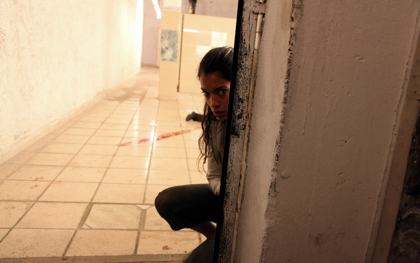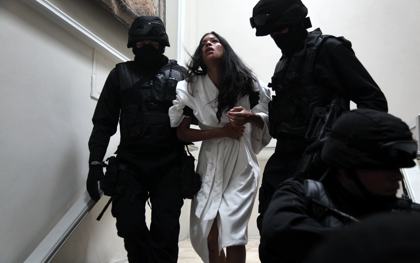Primary navigation


The story of a would-be beauty queen who falls foul of Mexico’s drug gangs, Miss Bala is more than just another document of Latin America’s social ills, says Paul Julian Smith
You could hardly wish for a higher concept: beauty queens meet drug barons. And Mexican director Gerardo Naranjo has a flashy track record: in Drama/Mex (2006) glossy model-types emote in beach houses in scenic Acapulco; in I’m Gonna Explode (Voy a explotar, 2008) sexy teens with cars and guns run wild in historic Guanajuato. Even the co-production between Fox International Productions (the specialist division of a US major) and Canana (Diego Luna and Gael García Bernal’s boutique Mexican outfit) fits the new film’s theme – like the movie, the drug business will prove to be transnational, boosted by cross-border collaboration.
Miss Bala’s title also boasts a cool pun. While bala means ‘bullet’ in Spanish, it also rhymes with Baja – as in Baja California, the state whose beauty pageant is hijacked by the local mafia in the film. The script (for which Naranjo takes co-credit) is based on a collage of headlines ripped from the front pages. A real-life beauty queen – Miss Sinaloa, named, like Naranjo’s character, Laura – was indeed charged with gang membership; an agent of the US Drug Enforcement Administration was recently killed by organised crime; and, as is well known, US weapon sales to Mexican cartels (also shown in the film) are massive and lucrative, in spite of loud American complaints of drug smuggling from south of the border.
But if the troubling truth is, indeed, stranger than fiction, then cinema has already been active in this area. Mexican audiences, who might seem to have good reason to forget their country’s real-life drug wars when they seek entertainment at the cinema, have recently flocked to two hit films on the topic that have been little seen abroad. Luis Estrada’s Hell (El infierno, 2010) is a pitch-black state-of-the-nation comedy, in which an emigrant returns to find that his pueblo has been taken over by the gangs – and that there is nothing to celebrate in the year of the centenary of the Mexican Revolution. Beto Gómez’s Saving Private Pérez (Salvando al soldado Pérez, 2011), meanwhile, is a clownish farce, in which an incompetent narco seeks to rescue his brother, who has been kidnapped in Iraq. Both rely on the clichéd figure of the crime boss in his white suit and gold chains.

But there’s more to Naranjo’s film than such stereotypes and facile contrasts. In the opening shot of Miss Bala, the camera pans over glamorous pictures pinned on a bedroom wall, including tragic icon Marilyn. A motto reads (in English): “Fashion Victim”. But for the future Miss Bala/Baja, the cliché will prove literally true. After a failed audition for a beauty pageant, the initially unglamorous Laura (played by impressive newcomer Stephanie Sigman) is taken by a friend to a seedy nightclub. Naranjo (or perhaps his DP, the Hungarian Mátyás Erdély) chooses to shoot the scene in depth, respecting the complexity of this unusual space. While Laura waits placidly in the bathroom, inspecting herself in the mirror, behind her and to the left we glimpse a surreal sight: gunmen drop silently down the wall into a corridor, in preparation for a massacre. Belatedly becoming aware of this invasion, Laura sinks to the floor and retreats into a corner. A drug baron (who she will later discover is called Lino), shown only from the waist down, comes into shot and listlessly tosses a roll of bills down to her.
This first shot of the unprepossessing Lino, in which he is faceless, is vital. Naranjo allows no identification with – much less celebration of – the drug barons. And by scoring the whole nightclub sequence to annoyingly repetitive norteño dance music, the low-key drama is disconcertingly heightened. After this initial chance encounter, there will be no escape for Laura from the tentacles of all-too-organised crime.
Against all expectations, Miss Bala shapes up as a surprisingly thoughtful thriller. There is unaccustomed solemnity in the pace of shooting and cutting, not to mention impressively underplayed performances from novices Sigman and Noe Hernández (as Lino). In his extended press notes, Naranjo insists on the violence and inequality of life in Mexico, tracing the narcos’ ghoulish mutilation of their victims’ bodies (illustrated daily on the front pages of newspapers) back to Aztec rituals that were equally gory. But his comments say more about a certain kind of Mexican self-image than they do about the film itself. In fact explicit violence is conspicuous by its absence in most of Miss Bala. And it’s only after some 70 minutes of screen time that Naranjo finally allows himself an action set piece – an operatic inferno filmed on the city street where Laura is caught in the crossfire between cartel and police.

As the film develops, we see that the deceptively simple technique rather than the high-profile subject matter is where its real originality lies. Surprisingly, perhaps, Laura is consistently shot from behind, her dark hair hanging down her back. The audience is thus encouraged to adopt the POV of this stranger in a strange world – a familiar enough strategy. But with our vision partially obscured by Laura’s head, the viewer is as disorientated as the increasingly shell-shocked character, who time and again wanders or blunders into mayhem. Naranjo has noted the lack of close-ups in his film, which denies us easy psychological proximity. But perhaps even more important is his frequent use of shallow focus: when two characters are shot together, more often than not one person’s image will be blurred. This is a society whose citizens are isolated from one another even when they share the same space.
In the same way, Miss Bala favours dreamy Steadicam shots that are difficult to interpret. In one early sequence, for example, the camera floats woozily over the heads of would-be contestants at the Miss Baja contest, suggesting that something strange is in the air. And indeed, as Laura drifts ever further into drug territory, the things she sees (and we see) become yet more surreal. Thus when the criminals induce her to transport money across the border, a lengthy sequence shows great wads of bills being solemnly taped to her slim waist. And after she is crowned queen (the drug cartels even control the beauty business), she is dumped outside town at night, and attempts to make her way across the desert dressed in high heels, chandelier earrings and a satiny pageant dress.
Much later, Laura will be led into an equally incongruous scenario: a luxury hotel, where guests sit placidly in a courtyard oblivious to the violence outside. Here she has an assignation with an elderly general – apparently all part of the job for beauty queens. The scene is shot by Naranjo, however, through the billowing clouds of the hotel-room humidifier, lending a surreal visual quality to an already sordid setting. And the odd couple’s tryst will soon be interrupted by a squadron of soldiers in black masks, eerily reminiscent of Darth Vader.
The late Argentine writer Julio Cortázar wrote a short story called ‘Casa tomada’ (literally ‘taken house’), in which a home is gradually invaded by unknown and unseen forces, obliging the complacent inhabitants to fall back and finally flee their living quarters. Once taken as an allegory of political repression (suggesting that the bourgeoisie sat idly by during the rise of dictatorships in Latin America), the story could now just as well apply to the insidious growth of the drug cartels. Indeed in Naranjo’s chilling vision, gangs – far from being glamorous – seem stubbornly everyday, their activities bleeding into the domestic life of the nation. Typically, Laura is given a homely nom de guerre by her comrades in arms: Canelita (‘little cinnamon’). And when she manages briefly to escape back to her modest home, it’s soon taken over by gang members, who spread out a prodigious display of weapons on the domestic floor. The house (like Laura herself and, Naranjo would suggest, all of Mexico) is well and truly taken.

At another point Naranjo cuts from the wounded gang members being ferried home in a truck – who are conspicuously unattractive – to glamorous beauty contestants rehearsing a Bob Fosse-style number in tights and hats. It’s a kind of contrastive editing that, given the film’s premise, is surprisingly rare in Miss Bala – and is never used for cheap shock value or facile irony. Rather it points to a key insight: that it’s increasingly hard to distinguish between contestants and casualties. While it would be a stretch to say that the merciless beauty business is as cut-throat as drug running, the former is shown to be wholly complicit with the latter.
Naranjo thus undercuts the most pervasive and seductive female myth in Latin America. Put simply, Laura is the anti-Ugly Betty. Model-tall and skinny from the start, she would seem to be ready for a Betty-style makeover. And like Betty, once more, Laura’s true beauty will be revealed by the end of the story: she is professionally made up and coiffed before staggering out on stage to win the longed-for contest. But unlike Betty (who got to marry her cute boss in the final episode), this new look brings Laura no personal or professional success. She remains throughout the film an accidental – and increasingly traumatised – tourist in the foreign territory of organised crime.
During the pageant, Laura is asked if her dream is money or fame. Struck dumb by her trials, she can answer only with tears. The oleaginous MC praises her “genuine emotion” as she stumbles off stage. It is a rare and bitter moment of humour, equalled only when Laura, finally paraded as a criminal on TV, is condemned for bringing the supposed good name of the beauty-pageant business (so superficial and corrupt) into disrepute.
In spite of such bizarre moments, Naranjo has spoken of the social accuracy of his depiction and his desire to educate foreigners in what is happening in his country. His film is certainly a welcome antidote to images of narcos in popular film as Robin Hoods or comic heroes. Yet in spite of undeniable and grotesque violence in Mexico (there has been a fearsome toll of casualties since the current president enlisted the army to fight crime), the country’s murder rate remains less than that of, say, Brazil, which attracts much less media attention. Americans are also unlikely to be aware that homicides in the capital Mexico, D.F. (Mexico City) are half those in Washington, D.C.

Moreover, while Naranjo claims in the press notes that his home country suffers the greatest inequality of income in the world, absolute poverty has in fact fallen, helped by initiatives such as a government cash-transfer programme that has been adopted as a model as far away as New York. The Economist wrote recently that the true cartels holding Mexico to ransom are not the drug gangs, but the monopolies in areas such as telephony (controlled by Mexican business magnate Carlos Slim, the world’s richest man), which charge ordinary Mexicans inflated fees for their services. Those same ordinary Mexicans prefer their local films to be comedies – it’s often foreigners who fund and distribute titles on the continuing social ills of Latin America. As one Mexican commentator wrote wryly, films like Miss Bala seems designed to make foreigners feel sorry for his home country.
Whether or not this is the case, Naranjo certainly succeeds in directing sympathy towards his hapless and hopeless protagonist. Laura will finally be set free by the police, who are in league with the cartel, but she is still dumped on a desolate street. The sound design is innovative here once more: we hear only a roar of white noise, which is impossible to interpret. This last sequence is a reminder that, in spite of its claims to reflect contemporary Mexico, Miss Bala cannot be reduced to realism. Naranjo’s film offers no facile psychological analysis of the criminals whose unglamorous daily lives it documents. But it also offers no easy remedy for the nightmarish social conditions to which it attests.
At the time of writing, Miss Bala has not yet opened in Mexican cinemas. But if local audiences fear that the film will trivialise or sensationalise their country’s predicament, they are wrong. When beauty queens meet drug barons, the financial stakes may be high, but in Naranjo’s impressive and ambitious feature, the artistic stakes are higher still.
‘Miss Bala’ screens at the BFI London Film Festival on 19, 20 & 22 October, is released on 28 October, and is reviewed in the November 2011 issue of Sight & Sound
Across the Bridge remembered by Paul Mayersberg (August 2011)
We Are What We Are reviewed by Paul Julian Smith (December 2010)
The Exterminating Angel + Simon of the Desert reviewed by Tim Lucas (April 2009)
Border control: Edward Buscombe on Once Upon a Time in Mexico (October 2003)
Pup fiction: Edward Lawrenson on Amores perros (May 2001)
Traffic reviewed by Andrew O’Hehir (February 2001)